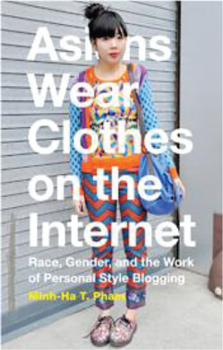Book Review
Pham, Minh-Ha T. Asians Wear Clothes on the Internet: Race, Gender, and the Work of Personal Style Blogging. (Durham, NC: Duke University Press, 2015.)
Skip other details (including permanent urls, DOI, citation information)
: This work is licensed under a Creative Commons Attribution-NonCommercial-NoDerivatives 3.0 License. Please contact [email protected] to use this work in a way not covered by the license.
For more information, read Michigan Publishing's access and usage policy.
In a series of photos taken on her balcony and posted on December 30, 2011, the internationally known fashion blogger Susanna Lau, also known as Susie Bubble, models for her followers an exuberantly patterned look that she dubs “party shirt time.” A caption details the outfit’s components: “Versace barocco shirt worn with vintage patterned cape from Thrifted & Modern, Miu Miu skirt from Yoox, Tabio socks, floral brogues from Tokyo.”[2] Crave the look? Hyperlinks whisk readers to retailers’ websites.
Something is missing from this photo and similar outfit shots posted by Lau, Bryan Grey Yambao, Rumi Neely, Aimee Song, and other Asian personal style bloggers whose metrics place them in the ranks of elite superbloggers. According to Minh-Ha T. Pham, what the photos do not show is work. In making the looks seem effortless, superbloggers elevate their own status by suggesting that they as individuals are naturally chic. Pham’s insightful study examines how this obscures the fact that their taste, as Pierre Bourdieu so convincingly demonstrated, is a form of capital resulting from work performed in particular historical, social, economic, political, and cultural contexts within hierarchies of class, gender, race, and sexuality. By attending to Asian superbloggers’ posts as a form of fashion labor, Asians Wear Clothes on the Internet both undoes this erasure and astutely probes its effects. The book addresses three linked questions: Why have Asian superblogs become so prominent in the early twenty-first century? Why are the tastes of Asian consumers now central to Western fashion economies? How does bloggers’ taste work transform their own gendered and racial bodily practices into forms of capital?
Pham’s analysis proceeds from the provocative claim that blogging must be understood as a form of racialized and gendered fashion labor that contributes to the accumulation of capital by the fashion industry. This compelling insight enables Pham to situate Lau, Yambao, and others within global circuits of fashion production in which Asian workers, particularly sewing machine operators, have played a central role. These groups are linked in complex ways. On the one hand, Asian superbloggers challenge stereotypes of Asian workers as not creative, but only because they consume goods produced by underpaid, alienated garment workers, most of whom are also Asian. On the other hand, Asian superbloggers share factory workers’ condition of being “positioned—hierarchically—in fashion’s productive system as a racially gendered supply of unwaged or underwaged labor” (12). Like the Asian garment workers who make the vast majority of the clothing that the world purchases, Asian superbloggers
occupy a common fraught position as a model minority labor supply believed to be oriented to hard work, yet racial assumptions about their natural facility for hard and difficult work put them in a position where they must bear the burden of demands (often discourteously made) for unreasonable amounts of work. (32)
Chapter 1 explores the dynamics of racialization in detail. While fashion has long been fascinated with Asia—think Chinoiserie and Asian Chic—the recent trend is notable for being driven by Asians themselves. Pham identifies three factors fueling the ascendancy of Asian fashion tastemakers. First, aesthetics of Asian “cute culture” have become globally popular by exuding a feminized aura of warmth, intimacy, and approachability. Second, booming Asian economies have explicitly repositioned Asian countries in global supply chains by emphasizing design work and mass consumption. Third, social commerce provides a means to tap into this growing market by connecting directly with real Asian consumers.
While Asian taste may be all the rage, Pham cautions that it can all too easily exceed the bounds of fashionable “legitimate difference” to produce what she calls “racial aftertaste.” Fashion superbloggers endure a variety of criticisms: They receive bribes to showcase particular brands and hence cannot be trusted. Their style is ostentatious or tacky. They are untalented, self-promoting, and fake. When conventional fashion journalists such as Suzy Menkes mock fashion bloggers in the hallowed pages of Vogue or The New York Times, the specific examples they cite are disproportionately Asian. Racial dynamics are central, yet obscured: “Attacks on bloggers that focus on the personal ethical failings of bloggers retain the discourse of progress while reasserting fashion’s dominant racial order, in which white Euro-American experts and consumers are the true arbiters of fashion and style” (77). Racialization, Pham convincingly demonstrates, is thus as central to fashion hierarchies in the blogosphere as on the factory floor.
The remainder of the book focuses on actual blogging practices: the style story or text accompanying photos (chapter 2), outfit photos (chapter 3), bloggers’ poses (chapter 4), and outfit posts (chapter 5). Throughout, Pham considers how racialized, gendered, and classed forms of work are present, yet hidden. The “choreographed spontaneity” (119) of outfit photos obscures the effort required to get the right shot, with complex results. Lau’s style stories suggest a form of racial neoliberalism, in which her Chineseness becomes a personal brand that expresses her consumer choice. Yambao employs racial camp to exaggerate his marginalization as a queer Filipino man and assert his own more elite association with luxury consumption. Even when particular bloggers’ looks become iconic fodder for imitation in fashion spreads, racialized dynamics work to obscure the bloggers’ creativity and labor. Susanna Lau’s “elsewhere gaze” transforms her own ambivalence about eyes as a racial marker into a valuable aesthetic statement, but in ways that reinforce notions of naturally occurring demure Asian femininity. A consistent message emerges: repeatedly met with responses that deskill their fashion work, superbloggers both challenge and reinforce hierarchies of race, class, and gender. Although Pham effectively illuminates the essentialism embedded in these dynamics, this concept might have received more direct attention, perhaps through considering how bloggers engage in what Gayatri Spivak has deemed the fraught politics of strategic essentialism.[3]
By exposing and critically unpacking racialization discourses, Asians Wear Clothes on the Internet powerfully illuminates the similarities between superblogging and other undervalued forms of Asian fashion labor. Methodologically, however, Pham’s consideration of blogs as verbal and visual texts might have been productively supplemented by interviews or participant observation. Such evidence would likely have strengthened her analysis of racialized labor by showing how embodied taste work actually unfolds during superblog production.
With Asians Wear Clothes on the Internet, Pham makes a significant contribution to scholarship on fashion, race, gender, and online media by eloquently demonstrating the ambivalent outcomes when Asianness becomes productive of economic and cultural value. While Asian superbloggers serve as evidence that the previously marginalized can gain entry into fashion’s highest status venues, Pham deftly shows that behind the veneer of this apparent democratization lies an unpaid or underpaid, racialized labor force. The book will be required reading for scholars in interdisciplinary fields focused on fashion, media, and the Asian diaspora. It would also make an excellent text for courses in fashion studies, ethnic studies, or media studies.
Ann Marie Leshkowich is Professor of Anthropology at College of the Holy Cross. She is author of Essential Trade: Vietnamese Women in a Changing Marketplace (University of Hawai’i Press, 2014; winner, Harry J. Benda Prize, 2016) and coeditor of Neoliberalism in Vietnam (special issue of positions: asia critique, 2012) and Re-orienting Fashion: The Globalization of Asian Dress (Berg, 2003).

Susanna Lau, “Party Shirt Time,” Style Bubble, December 30, 2011, http://stylebubble.co.uk/style_bubble/2011/12/party-shirt-time.html.

Gayatri Chakravorty Spivak, “Subaltern Studies: Deconstructing Historiography,” in Selected Subaltern Studies, ed. Ranajit Guha and Gayatri Chakravorty Spivak (New York: Oxford University Press, 1988), 3–32.

Bibliography
- Lau, Susanna. “Party Shirt Time.” Style Bubble, December 30, 2011. http://stylebubble.co.uk/style_bubble/2011/12/party-shirt-time.html.
- Spivak, Gayatri Chakravorty. “Subaltern Studies: Deconstructing Historiography.” In Selected Subaltern Studies, edited by Ranajit Guha and Gayatri Chakravorty Spivak, 3–32. New York: Oxford University Press, 1998.


